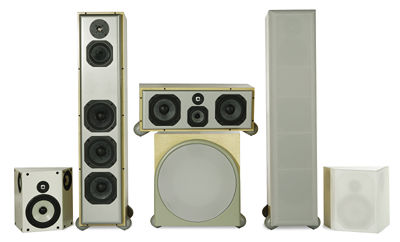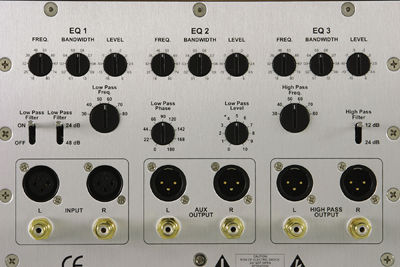Revel Performa F50 speaker system
A successful loudspeaker is, of course, the sum of all of its parts. As important as the cabinet, crossover network, and other elements are, though, drivers are the foundation. It's hardly surprising that the quest for the perfect driver began even before the debut of the first loudspeaker. The ultimate goal, for dynamic drivers at least, is getting the cone to act like a pure piston, preventing the diaphragm from changing form in any way as it moves in and out. Cone material is vitally important in several ways, not least of which is walking the fine line between having the low mass and speed necessary to respond to even the most subtle electrical cues and having the strength to endure punishment and the stiffness to avoid distortion-inducing cone breakup.

The halls of Harman have never been strangers to innovative driver design, starting way back with JBL, through Infinity, and now from the company's most recent speaker brand, Revel. Lately, the latter two brands have focused considerable attention on ceramics, which have several characteristics that make them ideal materials for cone drivers but were generally believed to be too brittle to endure everyday use. (Ceramics have been used before in driver construction, with varying degrees of success.) Infinity's solution is the well-regarded C.M.M.D. driver, a hybrid design that sandwiches ceramic layers around a metal core that provides increased endurance. Revel uses 100 percent ceramic construction and has developed a manufacturing process that provides the necessary strength but maintains the acoustic properties—stiffness and density, speed, and a higher inherent damping factor—that have made ceramics such an intriguing option. Revel's new F50 tower ($7,500/pair) and C50 center channel ($3,000) from the Performa line are the first to put this new driver philosophy to the test.
Revel's design, which they call a ceramic composite, seems simple enough on paper; in practice, it's anything but. In a nutshell, three layers of material—a core of polyethylene terephthalate (PET) and two outer layers of glass fiber—form a glass substrate. Geopolymer resin bonds the layers into a single, solid structure, and heat is applied to cure and transform the resulting molecular structure into a true ceramic material. Maybe it doesn't sound so simple on paper, either, but it works. If you know Revel, you know that they wouldn't have let it out the door unless they were completely satisfied with the results.
In the F50, the new drivers debut as three 6.5-inch woofers and a 5.25-inch midrange. The F50 also uses a different tweeter than its step-down sibling, the F30: It still uses a 1-inch dome, but the dome is constructed of pure titanium instead of aluminum alloy. New materials aside, the same successful philosophies that Revel has employed on their previous drivers are in place. These include matching the drivers to within 0.5 decibels of the company's reference units for precise timbre-matching; high-order crossover networks that increase power handling and reduce distortion by restricting the driver to its ideal operating bandwidth; physically separate woofer, tweeter, and midrange filter boards to further combat distortion; and massive overhung voice coils and large motor systems with tight tolerances. The crossover points are 225 hertz and 2.3 kilohertz. The F50's cabinet is 1-inch-thick MDF with extensive internal bracing and cavities (damped with Dacron and Fiberglas) that isolate the driver groups according to frequency range. The front baffle is rounded to reduce diffraction, and the cabinet is ported to the rear. The rear panel offers two sets of gold-plated binding posts for biamping/biwiring, plus a tweeter-level control that affects high-frequency balance and timbre. Four cast-aluminum feet (which can accept spikes) complete the structure, and wood-veneer finishes in cherry, sycamore, rosewood, or black ash help give the F50 considerable aesthetic appeal.
The horizontally aligned C50 center channel has the same tweeter as the F50, plus three ceramic-composite drivers: two 6.5-inch woofers and a 4-inch mid-range. The C50's crossover is also a high-order, three-way design. In addition to the same tweeter control as the F50, there's a valuable, three-position boundary-compensation switch (for flush-mount, top-of-the-monitor, or stand-mount placement). The cabinet is 0.75-inch-thick MDF, with the same internal bracing and isolation as the F50. The C50 also has a rounded front baffle, three removable and adjustable cast-aluminum feet that accept spikes, and the same choice of veneers.

With two-channel music, the first thing I noticed about the F50 was its imaging. I don't know that I've ever heard it done better. Even with little toe-in, lead vocals were dead-center with a perfect sense of front-to-back spacing, while instruments benefited from a deep and exceptionally well-defined stage. I was surprised by the image's stability, as well. Even when I toed it in at a considerable angle, the F50 has such good off-axis response that the image broke down very little as I moved from one side of the room to the other. The soundstage's depth and width suffer much less than you should reasonably expect from major toe-in, as well.
The next thing I noticed was midrange reproduction. With either Lexicon's MC-8 or MC-12 pre/pro and the LX-7 amp, the F50's midrange was as natural, accurate, and musical as I've heard on any system I've reviewed. I put a parade of my favorite voices through the MC-12/LX-7/F50 setup, and I was floored by the realism that it rendered. The 24/96 two-channel DAD mix of Muddy Waters' Folk Singer was particularly memorable. Thanks to excellent engineering on the software side and gripping fidelity on the hardware side, this is easily as close as a young pup like me has ever felt to sitting in the same room with one of my all-time favorites. The upper and lower frequency ranges were hardly less successful. The slide guitar can sound magical when done right, but it can make your skin crawl when done wrong. It was nothing but the former here; the new Revel tweeter did a masterful job of infusing the sound with its natural metallic qualities while it also maintained a firm grip that never let it degenerate into grating aggressiveness or ringing.





























































